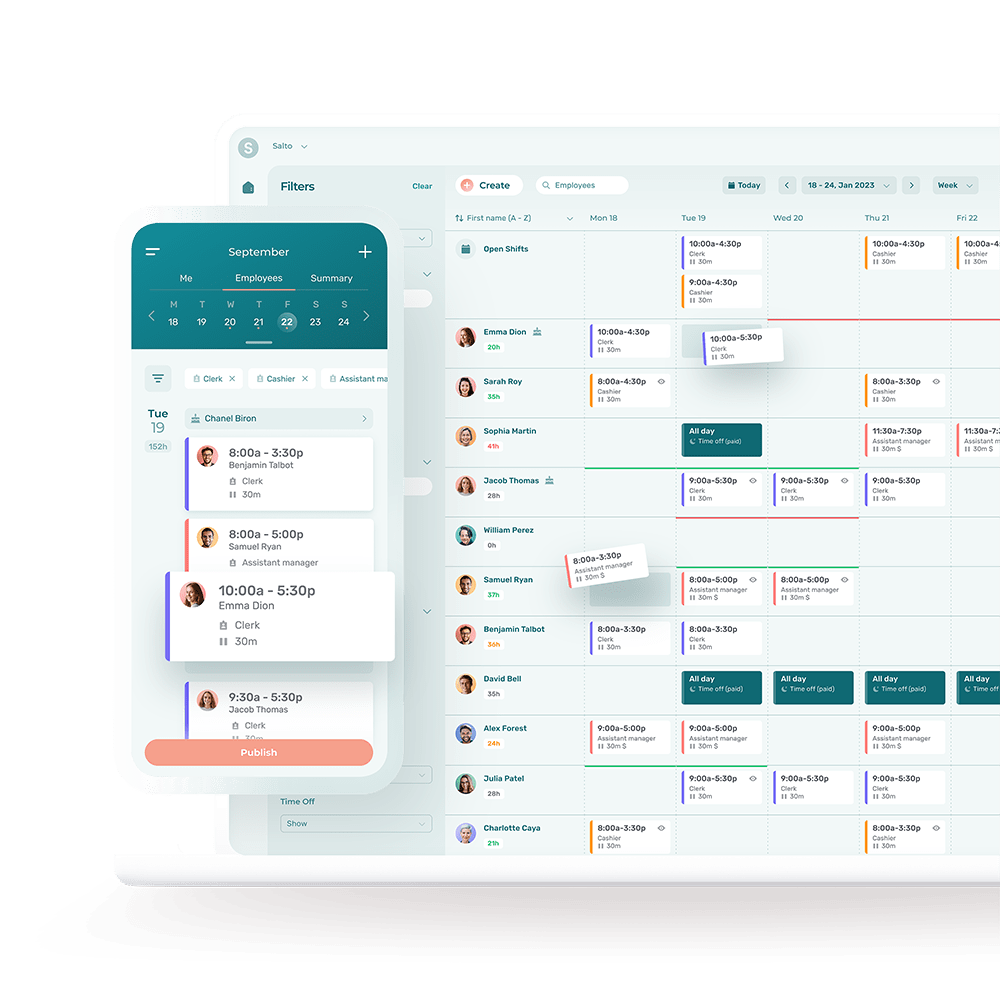Creating work schedules may not be your favorite task, but it’s essential to the success of your pharmacy.
It can be a real headache, especially if you wear the hat of both pharmacist and manager. On the other hand, creating and managing schedules is critical to the smooth operation of your pharmacy and the satisfaction of your employees.
A well-balanced, well-planned schedule not only ensures better customer service, it also helps your employees find a better work-life balance.
In this article, you will learn more about:
- The main responsibilities of a pharmacist/manager
- Factors to consider when creating your pharmacy’s schedules
- Examples of pharmacy work schedules
- Benefits of using scheduling software
- Frequently asked questions about using scheduling software
Your Main Responsibilities as a Pharmacist
A pharmacist’s main responsibilities often go far beyond preparing, storing and dispensing medicines to patients to ensure their health.
The profession of pharmacist often comes with responsibilities related to the smooth running of pharmacy operations, such as:
- Efficient day-to-day management: managing inventory, supervising the work of lab technicians, keeping up to date with pharmaceutical regulations, communicating with suppliers, etc.
- Customer service: advising patients, answering their questions, ensuring their safety, etc.
- Staff management: recruiting and hiring new employees, providing staff training, creating and managing work schedules, etc.
Related tasks are particularly important, as they directly influence your pharmacy’s reputation (and even your reputation, if your business bears your name).
Did you know that 78% of pharmacists work in the retail sector?
The quality of customer service can vary greatly depending on the different employees working in an establishment. That’s why pharmacist-owners should use best practices in personnel management to ensure the success of their business.
Scheduling Requirements for Pharmacies
Opening Hours
The first thing to consider when creating the opening hours for your pharmacy is its operating hours. Depending on your customers’ needs and employees’ availability, you can determine the most suitable opening hours for your business.
And don’t forget to take your suppliers’ delivery times into account, to ensure that someone will be there to receive the goods.
Some pharmacies may be open Monday to Friday between 8am and 6pm only, while others may choose to be open every day between 9am and 10pm, or even 24 hours a day.
Your Pharmacy’s Daily Requirements
Managing a pharmacy’s operational needs is intrinsically linked to the overall running of the business, and helps ensure its success.
So when you’re thinking about creating a schedule, don’t forget to take the following aspects into account:
- Inventory management: ensuring that the establishment offers products that meet customer needs, that these are available in sufficient quantities, that expired products are removed from shelves, etc.
- Compliance with existing laws and regulations: comply with existing regulations, including labor laws and regulations relating to pharmaceutical activities
- Patient safety: implementing protocols to protect patients and prevent errors
- Human resources management: respecting employees’ different roles and positions, creating and managing work schedules, offering relevant training, etc.
- Managing IT tools: using appropriate tools to protect patient and employee data, simplifying communication with healthcare professionals, etc.
This non-exhaustive list of operational needs provides a better understanding of the complexity of pharmacy operations.
The Different Types of Shift
Using different shift types when creating schedules will enable you to better take into account the needs of your pharmacy and those of your employees.
Here are some examples of the most common shifts:
- Day shifts: generally lasting 8 hours, between 8am and 6pm
- Evening shifts: can be longer or shorter depending on pharmacy opening hours, generally between 6pm and midnight
- Night shifts (if applicable): these shifts are generally more difficult for employees and can have a significant impact on their well-being, between midnight and 8am
- Weekend and holiday shifts: these shifts are often less popular, but can be interesting for students or people looking for part-time work
Each of these shifts has advantages and disadvantages that can influence employee well-being. It is therefore important to consider them when creating schedules.
Some employees may prefer certain shifts for various reasons. So it’s a good idea to ask them what their preferences are, in order to create a work schedule that works best for everyone.
Employee Needs and Requests
Employee scheduling also involves taking into account the needs and requests of employees to ensure a healthy working environment AND offer interesting, competitive working conditions.
Here are some examples of needs or requests your employees might have:
- Time-off requests: annual vacation, PTO, unpaid leave, etc.
- Unexpected absences: sick leave, no-shows, etc.
- Requests to swap shifts: to mitigate unforeseen circumstances, to accommodate an employee, etc.
- Overtime: to keep the company running
- Employee preferences: minimum and maximum hours per week, preferred shifts, etc.
- Work-life balance: flexible working hours, shift swapping, changing availability, etc.
Examples of Pharmacy Work Schedules
To give you a tangible idea of what a pharmacy schedule might look like, here are a few examples.
Feel free to download one of our work schedule templates to assist you with your planning.
1. Typical Pharmacy Work Schedule
A typical pharmacy schedule typically requires 1-2 pharmacists and 1-3 lab technicians to cover all opening hours of the day without imposing excessively long shifts on employees.
In addition to the staff behind the counter, the right number of cashiers and clerks are required to receive merchandise, place products on shelves and provide customer service.
Opening hours: 9am to 8pm, 7 days a week
Sample schedule for a typical day
- Cashier 1: 8:30am to 5pm
- Cashier 2: 4pm to 8:30pm
- Pharmacist 1: 8am to 4.30pm
- Pharmacist 2: 1pm to 8:30pm
- Laboratory technician 1: 8:30am to 5pm
- Laboratory technician 2: 1pm to 8:30pm
- Clerks: 10am to 6:30pm
2. 24-Hour Pharmacy Work Schedule
A 24-hour pharmacy requires considerably more staff. However, the number of employees required can also vary greatly depending on the volume of traffic.
For example, you may need more staff between 4 pm and 8 pm, and operate with fewer staff at night. Of course, a pharmacist must be present at all times.
This type of schedule often comes with major recruitment and staff retention issues due to night shifts.
Opening hours: 24/7
Sample schedule for a typical day
- Cashier 1: 7am to 3:30pm
- Cashier 2: 9am to 6pm
- Cashier 3: 3:30 pm to midnight
- Cashier 4: 11:30pm to 7:30am
- Pharmacist 1: 7am to 3:30pm
- Pharmacist 2: 12pm to 8:30pm
- Pharmacist 3: 5pm to 1am
- Pharmacist 4: 11:30pm to 7:30am
- Laboratory technician 1: 7.30am to 4pm
- Laboratory technician 2: 12:30 pm to 9 pm
- Laboratory technician 3: 4pm to midnight
- Lab technician 4: midnight to 8am
- Clerks: 7am to 3pm
3. Weekdays Only Pharmacy Work Schedule
Some pharmacies are only open on weekdays, as they share premises with a doctor’s office, for example. This type of establishment offers employees attractive working conditions that contribute to staff retention and recruitment.
Opening hours: Monday to Friday, 8 am to 5:30 pm
Sample schedule for a typical day
- Cashier 1: 7:30 am to 3:30 pm
- Cashier 2: 9am to 6pm
- Pharmacist 1: 7am to 3pm
- Pharmacist 2: 10am to 6pm
- Laboratory technician 1: 7:30 a.m. to 3:30 p.m.
- Lab technician 2: 9am to 6pm
- Clerks: 9am to 5:30pm
4. Flexible Pharmacy Work Schedule
Some pharmacies opt for a flexible schedule that varies according to the time of week. This allows customers to shop when it’s most convenient for them, as well as offering attractive working hours for employees.
Opening hours: Monday to Friday, 9 am to 8 pm, Saturday and Sunday, 10 am to 5 pm
Example of weekday schedule
- Cashier 1: 8:30 am to 5 pm
- Cashier 2: 4pm to 8:30pm
- Pharmacist 1: 8am to 4:30pm
- Pharmacist 2: 1pm to 8:30pm
- Laboratory technician 1: 8.30am to 5pm
- Lab technician 2: 1pm to 8:30pm
- Clerks: 10am to 6:30pm
Example of weekend schedule
- Cashier 1: 9:30 am to 5:30 pm
- Pharmacist 1: 9am to 5:30pm
- Laboratory technician 1: 10am to 5:30pm
- Clerks: 9am to 5:30pm
Tips and Tricks for Creating the Best Possible Schedule
Of course, each of these examples must be adapted to the reality of your establishment. You may need more or less staff, depending on how busy your pharmacy is.
Your employees’ schedules should always take into account break and lunch times. You also need to make sure you have enough staff on the floor to ensure great service to your patients and customers.
Above all, don’t neglect related tasks and don’t hesitate to add staff to ensure that all tasks are completed without putting unnecessary pressure on your team.
Finally, make sure you have enough staff to cover your employees’ planned and unplanned absences. To achieve this, don’t hesitate to hire part-time employees or students.
Scheduling Software: An Ally for Your Pharmacy
Using scheduling software is an important ally for pharmacists who wish to simplify and modernize their working methods and improve the well-being of their employees.
Save Time and Money
Using scheduling software will significantly reduce the time you spend creating and managing employee schedules.
You’ll be able to centralize all your tasks in one place. You’ll be able to create schedules directly in the software, share them with your employees and modify them as required. And it’s all accessible online, from any computer or mobile device.
Your employees will also be able to access their schedule at any time on their smartphone. You’ll even be able to see whether they’ve consulted it or not.
You can also centralize your communications with your employees. That way, you can avoid spending hours answering emails, text messages or even returning calls from your team members.
Scheduling software will also help you reduce the number of scheduling errors, thereby increasing employee satisfaction.
You can even centralize and manage employee files directly in Agendrix scheduling software. So you won’t have to waste time searching in your different software to find the information you need.
Keep Better Track of Time and Attendance
Most scheduling software also tracks employee time and attendance.
Employees can clock in and out directly into the software. The software records everything and identifies clockings that differ from the work schedule. This means you can quickly approve worked hours and send them to payroll software with a single click.
Using the right tools not only makes you more efficient, but also reduces wasted time. You can quickly identify repeated or unjustified employee absences, for example.
Automate Your Processes
One of the most important advantages of scheduling software is that it automates HR processes in your company.
For example, you can create schedule templates to make it easier to create new schedules each week. This makes it easier for you to create rotating schedules to keep your employees happy.
You also have access to each employee’s leave bank at a glance, enabling you to better manage leave requests. Staff can make their requests directly in the software, and you can approve them with just a few clicks. The schedule is automatically updated to avoid oversights.
Scheduling software such as Agendrix offers a wide range of features to help managers modernize their management methods.
Some even offer a free version for you to try out.
Find Out How These Pharmacists Transformed Their Scheduling Practices
Many pharmacists who have decided to use Agendrix scheduling software have seen real benefits in their businesses.
For example, Jessica, owner-pharmacist, has switched from paper and pencil to Agendrix. She explains that she is now able to create her schedules 2 times faster than before. What’s more, centralizing all her pharmacy’s information means she can create schedules several months in advance, and modify them as and when required according to employee availability and constraints.
It shouldn’t take so long to make our schedules. Saving that time allows us to invest it where it really counts.
– Jessica Bouchard, Pharmacist and Owner – Familiprix
Alex Caron, also a pharmacist-owner, has managed to reduce the time he spent creating and managing work schedules from 3 hours to just 25 minutes a week. He explains that with Agendrix, it’s easier to update the schedule and ensure that employees always have access to the latest version.
He explains that with Agendrix, it’s easier to update the schedule and ensure that employees always have access to the latest version.
There were so many changes to the schedule that keeping an up-to-date version with all the right information was a real challenge.
– Alex Caron, Pharmacist and Owner – Accès Pharma
Managers who use scheduling software like Agendrix are able to complete their tasks much more quickly and efficiently.
Conclusion
Creating work schedules for your pharmacy is no easy task. It requires a thorough understanding of your responsibilities as a manager and pharmacist, the operational needs of your business, modern employee management methods, and so on.
Using scheduling software such as Agendrix allows you to simplify your processes and ensure that you have all the information you need at your fingertips.
Try Agendrix now!
How to Create a Schedule for Pharmacy Employees?
Steps to create a work schedule for pharmacy employees include:
- Assessing the pharmacy’s needs: opening hours, traffic, labor costs, etc.
- Considering employees’ needs and preferences: availability, time-off requests, work/life balance, etc.
- Determining the number of employees required for each position: cashier, pharmacy technician, clerk, housekeeping, etc.
- Creating the different shifts to be filled
- Scheduling employees for shifts based on their availability, seniority, and preferences can be done efficiently using scheduling software or a work schedule template
- Making sure to comply with all applicable labor laws
- Sharing the work schedule with employees
What Are the Advantages of Using Pharmacy Scheduling Software?
The benefits of using pharmacy scheduling software include:
- Saving money
- Saving time
- Increasing employee satisfaction
- Reducing staff turnover
- Automating management processes
- Centralizing personnel management tasks
- Protecting employee data
- Reducing scheduling and payroll errors












